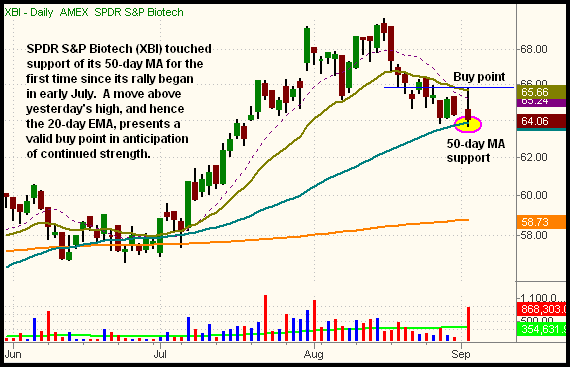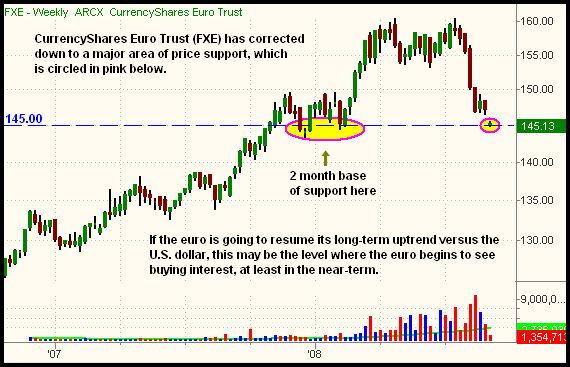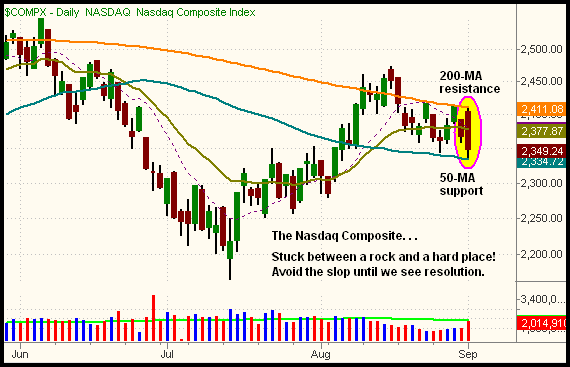|
The Wagner Daily ETF Report For September 3
Volume returned to the stock market yesterday, but the tug-of-war between the bulls and bears remained. Trading got off to an enthusiastic start, as all the major indices gapped open more than 1% higher, but the sellers quickly took control. Thirty minutes into the trading session, stocks began heading south, and continued doing so throughout the entire day. By the closing bell, each of the main stock market indexes were seeing red. The Nasdaq Composite fell 0.8%, the S&P 500 0.4%, and the Dow Jones Industrial Average 0.2%. The small-cap Russell 2000 only slipped 0.1%, but the S&P Midcap 400 shed 1.0%. Like the previous day, all the major indices settled near their intraday lows.
As anticipated, turnover jumped substantially. Total volume in the NYSE surged 50% above the previous day's level, while volume in the Nasdaq rose 37%. Though it was good to see the return of institutional trading activity, it was negative that the first day of strong volume was accompanied by persistent selling throughout the day. The broad-based losses on higher volume caused both the S&P 500 and Nasdaq Composite to register a bearish "distribution day," indicative of selling by mutual funds, hedge funds, and other institutional players. In the Nasdaq, declining volume exceeded advancing volume by a ratio of 2 to 1. The NYSE adv/dec volume ratio managed to remain marginally positive.
Like many other sectors, biotechs got off to a strong start yesterday morning, but eventually fizzled out alongside of the broad market. Nevertheless, we have not yet declared the end of relative strength in the healthcare arena. In fact, if the stock market manages to hold up, several of the biotech ETFs are presenting low-risk buying opportunities. One such ETF is SPDR S&P Biotech (XBI), which corrected to touch support of its 50-day MA for the first time since its current rally began in early July of this year. If XBI manages to rally above yesterday's high, it will correspond to a move above its 20-day exponential moving average (EMA), and present a valid buying point as well:

Yesterday, the U.S. dollar spiked to close near its highest level of the year, putting additional pressure on commodities and their associated ETFs. However, the weekly chart of CurrencyShares Euro Trust (FXE), an ETF proxy for the direction of the euro vs. the U.S. dollar, is now showing substantial price support at current levels. This is marked by the dashed horizontal line on the chart below:

By pointing out this major area of support, we are not advocating a buy entry into FXE just yet. Rather, we're giving you an early heads-up of an ETF that may be forming a bottom from its intermediate-term correction. At the least, just keep FXE on your radar and wait for some sort of bullish reversal pattern to develop on the short-term charts. Moreover, if strength in the U.S. dollar starts to subside, it may have a positive effect on the price of numerous commodity ETFs, which have largely been moving in the opposite direction of the U.S. dollar.
The Nasdaq Composite, which we analyzed in detail yesterday, again tried, but failed, to move above its 200-day moving average (MA). It was the third failed attempt in the past seven days. Once again, the amazing power of the 200-day MA "brick wall" is shown on the daily chart below:

Not only did the Nasdaq reverse after touching its 200-day MA, it also closed way down at the bottom of its recent sideways trading range. Notice that a solid break below yesterday's low would correlate to a break of the 50-day MA. If that happens, the intermediate-term trend of the Nasdaq will join the long-term trend by shifting from neutral to bearish. Both the S&P 500 and Dow Jones Industrial Average also closed just above their 50-day MAs, but remain near the middle of their recent sideways ranges.
Yesterday's price action in the broad market was simply par for the course. Over the past week, we've been reiterating the danger of putting much faith into the direction of the stock market until the major indices clearly show their hand. Specifically, we have been waiting for the main stock market indexes to close above their clearly-defined levels of resistance, or below their pivotal levels of support that we've illustrated in recent days. Since neither of those scenarios happened yesterday, we preserved capital by avoiding getting sucked into new ETF trade entries. Patience to sit on the sidelines and do nothing has been paying huge dividends lately. Remember the best traders are out of the markets more than they're in the markets, which allows them to keep their previously hard-earned profits in more challenging market conditions. Don't be a hero by trying to catch every market gyration right now, as each one has merely been occurring within the context of a choppy, sloppy sideways range.
Open ETF positions:
Long - IYH, TAN
Short -
Deron Wagner is the Founder and Head Trader of both Morpheus Capital LP, a U.S. hedge fund, and Morpheus Trading Group, a trader education firm launched in 2001 that provides daily technical analysis of the leading ETFs and stocks. For a free trial to the full version of The Wagner Daily or to learn about Wagner's other services, visit MorpheusTrading.com or send an e-mail to deron@morpheustrading.com.
|